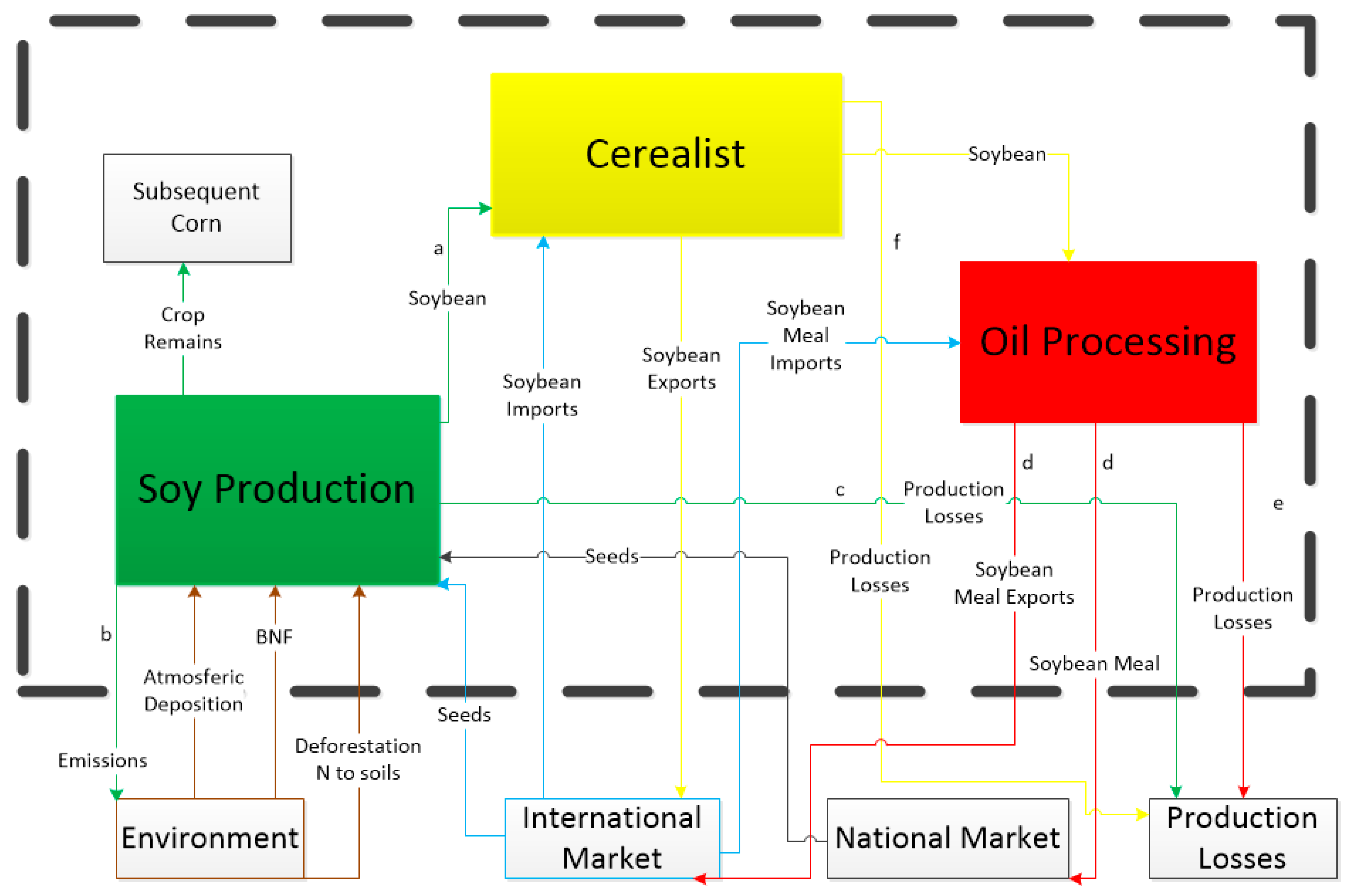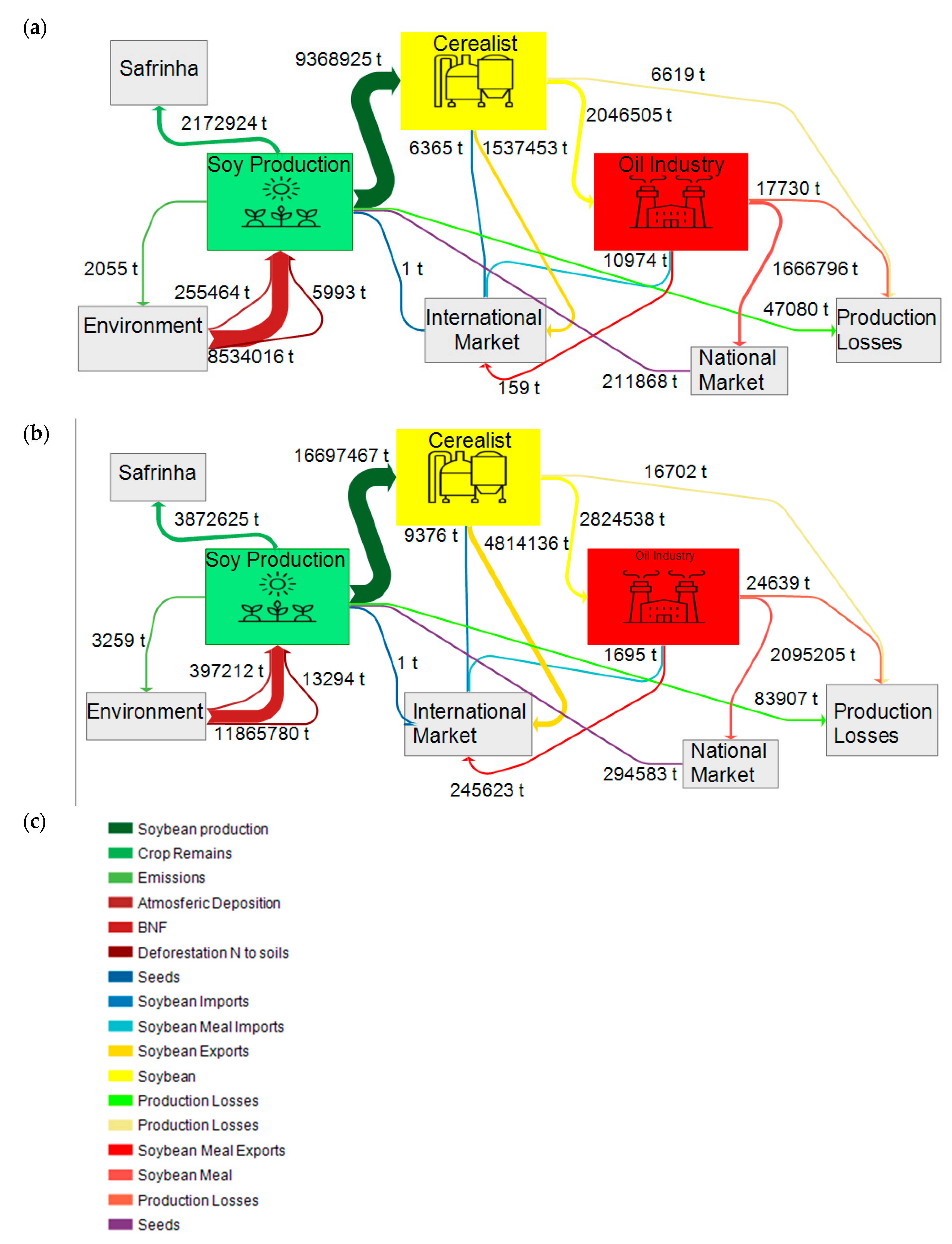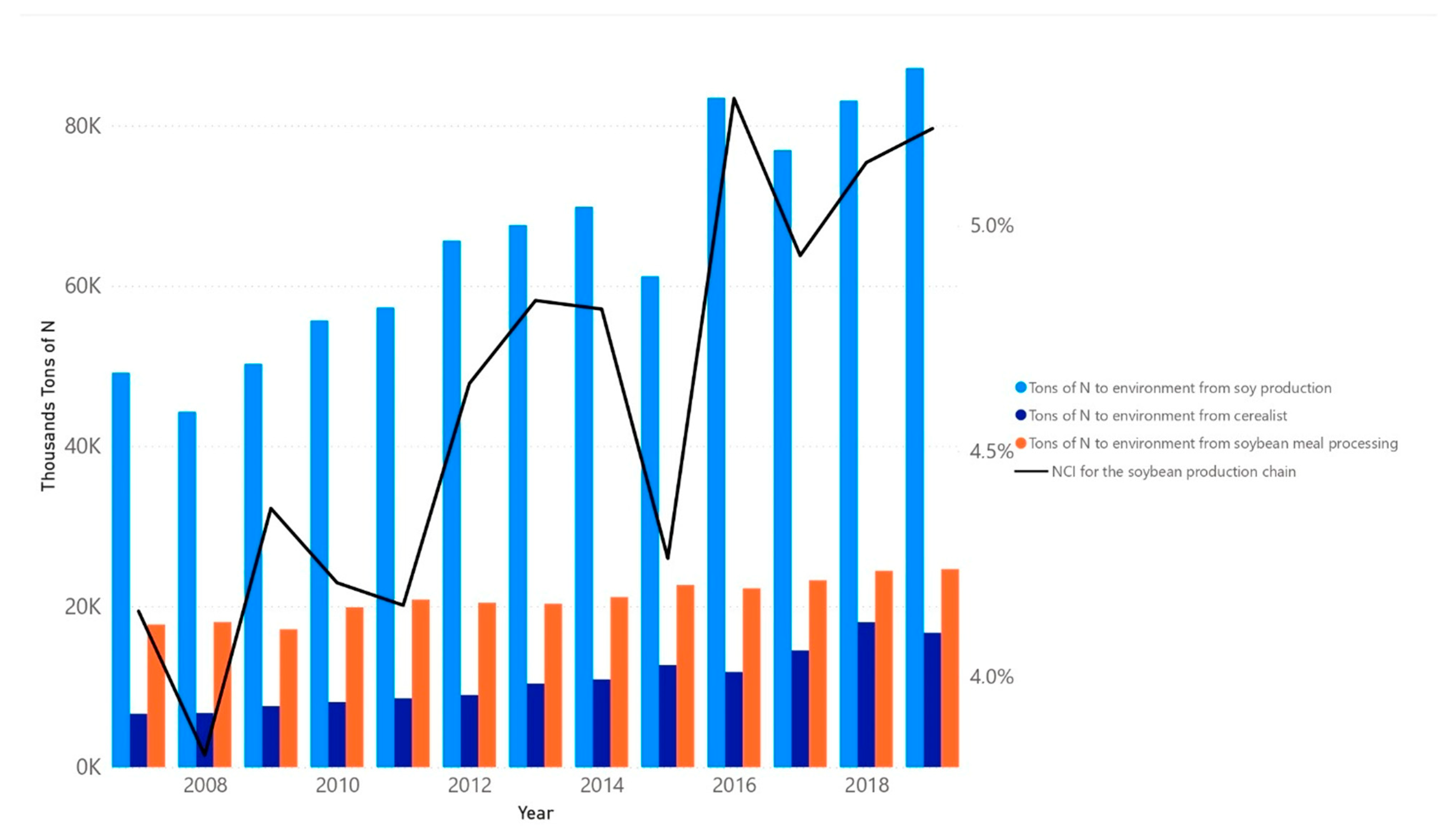Cascade Effect of Nitrogen on Brazilian Soybean Production Chain
Abstract
:1. Introduction
2. Materials and Methods
2.1. Soy Production System Considered in the Model
2.2. Efficiency Indicators in the Use of Nitrogen and the Cascade Effect
3. Results
3.1. Nitrogen Inputs and Outputs in the Brazilian Soybean Production System
3.2. Nitrogen Use Efficiency (NUE) and Nitrogen Cascade Indicator (NIC) on Brazilian Soy Production Chain
4. Discussion
5. Conclusions
Author Contributions
Funding
Data Availability Statement
Conflicts of Interest
Appendix A
Appendix A.1. The Inputs and Outputs Considered in the Nitrogen Balance in the Soybean Production Stage Were
Appendix A.1.1. Inputs
- Atmospheric deposition: Important process of removing nitrogenous compounds and other pollutants from the air to the Earth’s surface, which can occur in the form of wet deposition and dry deposition. The values considered in this study were: for the central and southern region of Brazil: 8 kg of N/ha/year, and for the Amazon region of 4 kg of N/ha/year [29].
- Biological Nitrogen Fixation: Process of transforming nitrogen gas (N2) into structures assimilable by other organisms, especially plants. Value considered in this study 180 kg of N/ha/year [30].
- Planted area and productivity: hectares of soy planted area in Brazil per year. The productivity of Brazilian soybeans per year (kg/ha) [13].
- Need for seeds for planting: Considering that 68.75 kg per hectare of soybean seeds are needed, to guarantee a stand of 250 thousand plants per hectare with 80% germination power and 10% more insertion in the number of seeds in the field for possible losses by pests and errors in sowing [31].
- Importation of seeds for planting: Brazilian import of soybean seeds for planting. Common Mercosur Nomenclature (NCM) considered: 12010010—Soybeans for sowing, 12011000—Soybeans, even crushed, for sowing [32].
- Consumption of national seeds: The difference between the need for seeds for planting and the amount of imported seed.
- New land for planting soybeans: The difference in the planted area from one year to the next was considered as new areas for planting soybeans. They were divided between the biomes: Amazonia, Cerrado, and Pampa. Emissions were calculated considering that 22% of the Cerrado areas came from deforestation, 5% from the Amazon areas, and 8.2% from the areas in the Pampa, and the remainder from conversion from pastures to crops. Nitrogen Emissions to Land Use Change and Deforestation was calculated using the values of 0.75 Kg N/ha for Land Use Change from pastures and Deforestation of Pampa Biome. Values of 3.95 Kg N/ha for Amazon Deforestation and 4.75 Kg N/ha for Cerrado Deforestation [14,22,33,34,35].
Appendix A.1.2. Outputs
- Harvested Soy: Amount of soybeans harvested [13].
- Produced Soy: Amount of grains harvested plus 0.5% losses during harvest.
- Harvest and Transport Losses: Consideration of losses related to road transport from the farm to the grain store and losses during harvest. Value considered, 0.5% [36].
- Crop Remains: Amount of nitrogen present in the leaves and stem of the soybean plant at the time of harvest, estimated at 15 kg of nitrogen for every 1000 kg of soybeans produced per hectare [30].
Appendix A.2. Inputs and Outputs Considered in the Nitrogen Balance in the Grain Storage Stage (Cerealist)
Appendix A.2.1. Inputs
- Harvested Soy: Amount of soybeans harvested [13].
- Soy imports: Soy grain imports considering the following NCM: 12019000—Soy, whether or not ground, except for sowing. 12010090—Other soya beans, whether or not ground [32].
- Initial stock: Quantity of soybeans stored, at the beginning of the current year, in storage units of industries, tradings, cooperatives and cerealists [22].
Appendix A.2.2. Outputs
- Grain Processing: Quantity of soybeans for industrial processing [22].
- Grain exports: Export of soybeans considering the following NCM: 12019000—Soy, whether or not ground, except for sowing. 12010090—Other soya beans, whether or not ground [32].
- Final stock: Quantity of soybeans stored at the end of the current year, in storage units of industries, tradings, cooperatives and cereal producers [22].
- Losses during the process: Losses of grain storage (0.9%), and losses related to transportation to the processing industry or port (0.25%) [36].
Appendix A.3. Inputs and Outputs Considered in the Nitrogen Balance in the Industrial Soybean Processing Stage
Appendix A.3.1. Inputs
- Initial soybean meal stock: Amount of soybean meal stored at the beginning of the current year by the processing sector [22].
- Import of soybean meal: Amount of soybean meal imported by Brazil considering the NCM: 23040010—Flours and pellets, from the extraction of soybean oil. 23025000—Bran, meal and other leguminous residues [32].
- Grains targeted for processing: Amount of soybeans destined for industrial processing [22].
Appendix A.3.2. Outputs
- Export of soybean meal: Amount of soybean meal exported by Brazil, considering the NCM: 23040010—Flours and pellets, from the extraction of soybean oil. 23025000—Bran, meal and other leguminous residues [32].
- Internal consumption of soybean meal: The difference between the amount of soybean meal produced by the industry and the amount of soybean meal exported.
- Final stock: Amount of soybean meal stored at the end of the current year by the processing sector [22].
- Losses during the industrial process: Losses from grain processing and transportation of soybean meal, amount of 1% of losses [36].
References
- Bouwman, A.F.; Beusen, A.H.W.; Billen, G. Human alteration of the global nitrogen and phosphorus soil balances for the period 1970–2050. Glob. Biogeochem. Cycles 2009, 23. [Google Scholar] [CrossRef]
- Lassaletta, L.; Billen, G.; Grizzetti, B.; Anglade, J.; Garnier, J. 50 year trends in nitrogen use efficiency of world cropping systems: The relationship between yield and nitrogen input to cropland. Environ. Res. Lett. 2014, 9, 105011. [Google Scholar] [CrossRef]
- Galloway, J.N.; Cowling, E.B. Reactive Nitrogen and The World: 200 Years of Change. Ambio 2002, 31, 64–71. [Google Scholar] [CrossRef] [PubMed]
- Rockström, J.; Steffen, W.; Noone, K.; Persson, Å.; Chapin, F.S., III; Lambin, E.; Lenton, T.M.; Scheffer, M.; Folke, C.; Schellnhuber, H.J.; et al. Planetary Boundaries: Exploring the Safe Operating Space for Humanity. Ecol. Soc. 2009, 14, 32. [Google Scholar] [CrossRef]
- Rockström, J.; Edenhofer, O.; Gaertner, J.; Declerck, F. Planet-proofing the global food system. Nat. Food 2020, 1, 3–5. [Google Scholar] [CrossRef] [Green Version]
- IPCC. Chapter 6: Carbon and Other Biogeochemical Cycles; IPCC: Geneva, Switzerland, 2013; Volume 5. [Google Scholar]
- Uwizeye, A.; De Boer, I.J.M.; Opio, C.I.; Schulte, R.P.O.; Falcucci, A.; Tempio, G.; Teillard, F.; Casu, F.; Rulli, M.; Galloway, J.N.; et al. Nitrogen emissions along global livestock supply chains. Nat. Food 2020, 1, 437–446. [Google Scholar] [CrossRef]
- Billen, G.; Lassaletta, L.; Garnier, J. A vast range of opportunities for feeding the world in 2050: Trade-off between diet, N contamination and international trade. Environ. Res. Lett. 2015, 10, 025001. [Google Scholar] [CrossRef]
- Galloway, J.N. The global nitrogen cycle: Changes and consequences. Environ. Pollut. 1998, S1, 15–24. [Google Scholar] [CrossRef]
- Peyraud, J.; Cellier, P.; Donnars, C.; Réchauchère, O. Les flux d’azote liés aux élevages. Cultures 2012, 68, 572. [Google Scholar]
- Galloway, J.N.; Aber, J.D.; Erisman, J.W.; Seitzinger, S.P.; Howarth, R.W.; Cowling, E.B.; Cosby, B.J. The Nitrogen Cascade. Bioscience 2003, 53, 341–356. [Google Scholar] [CrossRef]
- Cattelan, A.J.; Dall’Agnol, A. The rapid soybean growth in Brazil. OCL 2018, 25, D102. [Google Scholar] [CrossRef] [Green Version]
- CONAB, Companhia Nacional de Abastecimento. Safra Brasileira de Grãos. Available online: https://www.conab.gov.br/info-agro/safras/graos (accessed on 27 January 2021).
- Rausch, L.L.; Gibbs, H.K.; Schelly, I.; Brandão, A., Jr.; Morton, D.C.; Filho, A.C.; Strassburg, B.; Walker, N.; Noojipady, P.; Barreto, P.; et al. Soy expansion in Brazil’s Cerrado. Conserv. Lett. 2019, 12, e12671. [Google Scholar] [CrossRef]
- Filoso, S.; Martinelli, L.A.; Howarth, R.W.; Boyer, E.W.; Dentener, F. Human activities changing the nitrogen cycle in Brazil. Biogeochemstry 2006, 79, 61–89. [Google Scholar] [CrossRef]
- Galloway, J.N.; Townsend, A.R.; Erisman, J.W.; Bekunda, M.; Cai, Z.; Freney, J.R.; Martinelli, L.A.; Seitzinger, S.P.; Sutton, M.A. Transformation of the Nitrogen Cycle: Recent Trends, Questions, and Potential Solutions. Science 2008, 320, 889–892. [Google Scholar] [CrossRef] [PubMed] [Green Version]
- Xu, Z.; Chau, S.N.; Ruzzenenti, F.; Connor, T.; Li, Y.; Tang, Y.; Li, D.; Gong, M.; Liu, J. Evolution of multiple global virtual material flows. Sci. Total. Environ. 2019, 658, 659–668. [Google Scholar] [CrossRef] [PubMed]
- Zhang, X.; Davidson, E.A.; Zou, T.; Lassaletta, L.; Quan, Z.; Li, T.; Zhang, W. Quantifying Nutrient Budgets for Sustainable Nutrient Management. Glob. Biogeochem. Cycles 2020, 34, e2018GB006060. [Google Scholar] [CrossRef] [Green Version]
- Billen, G.; Lassaletta, L.; Garnier, J. A biogeochemical view of the global agro-food system: Nitrogen flows associated with protein production, consumption and trade. Glob. Food Secur. 2014, 3, 209–219. [Google Scholar] [CrossRef]
- Gameiro, A.H.; Bonaudo, T.; Tichit, M. Nitrogen, phosphorus and potassium accounts in the Brazilian livestock agro-industrial system. Reg. Environ. Chang. 2018, 19, 893–905. [Google Scholar] [CrossRef]
- AgriBenchmark. Cash Crop. Available online: http://www.agribenchmark.org/cash-crop/sector-country-farm-information/country-profiles/brazil.html (accessed on 27 January 2021).
- ABIOVE, Associação Brasileira das Indústrias de Oléos Vegetais. Estatítiscas. Available online: https://abiove.org.br/estatisticas/ (accessed on 27 January 2021).
- Gerber, P.; Uwizeye, A.; Schulte, R.; Opio, C.; De Boer, I.; De Boer, I. Nutrient use efficiency: A valuable approach to benchmark the sustainability of nutrient use in global livestock production? Curr. Opin. Environ. Sustain. 2014, 9–10, 122–130. [Google Scholar] [CrossRef]
- Herrero, M.; Wirsenius, S.; Henderson, B.; Rigolot, C.; Thornton, P.; Havlík, P.; De Boer, I.; Gerber, P.J. Livestock and the Environment: What Have We Learned in the Past Decade? Annu. Rev. Environ. Resour. 2015, 40, 177–202. [Google Scholar] [CrossRef]
- Zhang, X.; Davidson, E.A.; Mauzerall, D.L.; Searchinger, T.D.; Dumas, P.; Shen, Y. Managing nitrogen for sustainable development. Nat. Cell Biol. 2015, 528, 51–59. [Google Scholar] [CrossRef] [Green Version]
- Péra, T.G.; Caixeta-Filho, J.V. Perdas na logística de soja e milho no brasil: Contribuições para o fortalecimento do agronegócio. In Proceedings of the XXI SEMEAD Seminários em Administração, São Paulo, Brazil, 6–8 November 2018. [Google Scholar]
- Herridge, D.F.; Peoples, M.B.; Boddey, R.M. Global inputs of biological nitrogen fixation in agricultural systems. Plant Soil 2008, 311, 1–18. [Google Scholar] [CrossRef]
- Sun, J.; Mooney, H.; Wu, W.; Tang, H.; Tong, Y.; Xu, Z.; Huang, B.; Cheng, Y.; Yang, X.; Wei, D.; et al. Importing food damages domestic environment: Evidence from global soybean trade. Proc. Natl. Acad. Sci. USA 2018, 115, 5415–5419. [Google Scholar] [CrossRef] [PubMed] [Green Version]
- Vet, R.; Artz, R.S.; Carou, S.; Shaw, M.; Ro, C.-U.; Aas, W.; Baker, A.; Bowersox, V.C.; Dentener, F.; Galy-Lacaux, C.; et al. A global assessment of precipitation chemistry and deposition of sulfur, nitrogen, sea salt, base cations, organic acids, acidity and pH, and phosphorus. Atmos. Environ. 2014, 93, 3–100. [Google Scholar] [CrossRef]
- Hungria, M.; Campo, R.J.; Mendes, I.C. Fixação biológica do nitrogênio na cultura da soja. Embrapa Soja 2001, 35, 48. [Google Scholar]
- EMBRAPA. Tecnologias de Produção de Soja—Região Central do Brasil 2014; Sistemas de Produção: Londrina, Brazil, 2014; p. 242. [Google Scholar]
- MDIC, Ministério da Indústria, Comércio Exterior e Serviços. COMEXSTAT-Estatísticas do Comércio Exterior do Brasil. Available online: http://comexstat.mdic.gov.br/pt/home (accessed on 27 January 2021).
- Verchot, L.V.; Davidson, E.A.; Cattânio, H.; Ackerman, I.L.; Erickson, H.E.; Keller, M. Land use change and biogeochemical controls of nitrogen oxide emissions from soils in eastern Amazonia. Glob. Biogeochem. Cycles 1999, 13, 31–46. [Google Scholar] [CrossRef]
- Kuplich, T.M.; Coapone, V.; Costa, L.F.F. O Avanço da soja no bioma Pampa. Boletim Geográfico do Rio Grande do Sul 2018, 31, 83–100. [Google Scholar]
- Bustamante, M.; Medina, E.; Asner, G.; Nardoto, G.; Garcia-Montiel, D. Nitrogen cycling in tropical and temperate savannas. Biogeochemistry 2006, 79, 209–237. [Google Scholar] [CrossRef]
- APROSOJA, Associação dos Produtores de Soja. Cartilha Para Minimizar Perdas. Available online: http://www.aprosoja.com.br/comunicacao/release/aprosoja-lanca-cartilha-para-minimizar-perdas (accessed on 27 January 2021).



Publisher’s Note: MDPI stays neutral with regard to jurisdictional claims in published maps and institutional affiliations. |
© 2021 by the authors. Licensee MDPI, Basel, Switzerland. This article is an open access article distributed under the terms and conditions of the Creative Commons Attribution (CC BY) license (https://creativecommons.org/licenses/by/4.0/).
Share and Cite
Rezende, V.T.; Bonaudo, T.; Alves, R.B.; Nacimento, R.A.; Gameiro, A.H. Cascade Effect of Nitrogen on Brazilian Soybean Production Chain. Nitrogen 2021, 2, 128-138. https://0-doi-org.brum.beds.ac.uk/10.3390/nitrogen2020009
Rezende VT, Bonaudo T, Alves RB, Nacimento RA, Gameiro AH. Cascade Effect of Nitrogen on Brazilian Soybean Production Chain. Nitrogen. 2021; 2(2):128-138. https://0-doi-org.brum.beds.ac.uk/10.3390/nitrogen2020009
Chicago/Turabian StyleRezende, Vanessa Theodoro, Thierry Bonaudo, Ricardo Barboza Alves, Rafael Araújo Nacimento, and Augusto Hauber Gameiro. 2021. "Cascade Effect of Nitrogen on Brazilian Soybean Production Chain" Nitrogen 2, no. 2: 128-138. https://0-doi-org.brum.beds.ac.uk/10.3390/nitrogen2020009






